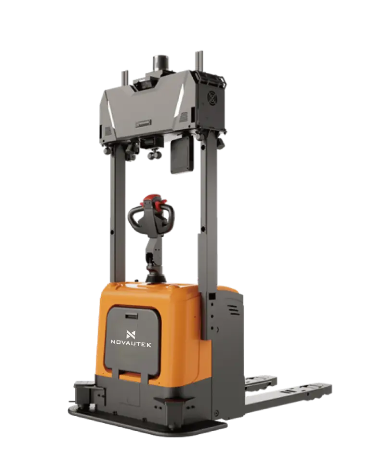Tecnologie Fondamentali che Alimentano Caruum automatarum
Fusio Sensorium et Systema Navigationis LiDAR
Fusio sensorum eminet ut una e technologis clavis quae robotas forklift autonomous sapientiores facit. Coniunctis sensorum variis, ut camerae, radaribus, et ultrasonicis detegtoribus, haec machinae meliorem cognitionem praebent quae circa eos agitur. Systema quasi omnia haec informationes in unum coagulant ut quasi completam ambientis imaginem repraesentent, quod robotae meliora iudicia ferre permittit dum per magazina movetur. Cum LiDAR technologia coniuncta, id est Detectio et Rangorum Luminis, hic optime operatur. Hae machinae radiis laser evectis usant detailed mappas regionum circumdantium creandi, ut forklift tutius per ambulare, sine ictibus in res vel personas. Experientiae etiam mirabiles effectus ostendunt. Magazina cum circa 30% minus navigationis errores postquam utraque systemata, fusionis sensorum et LiDAR, implementaverunt, in crevit in tutamine loci operis et in generali operationis efficacia.
Algoritmi Decisionales Impulsati ab Intellectu Artificiali
Cervus, qui ducit logisticam aequiparum automatarum? Hoc sunt algorithmi decisionum AI. Haec systemata sapientia data viva tractant per diem, adiuvans robots intellegere quid proxime agendum sit et statim reagere, cum circumstantiis mutatis. Ita cogita: cum magazinum turbatum est aut aliquid male fit, haec machinae non congelantur. Sed statim accommodantur. Verba ut "reteurola" et "discrimina machinarum" vere in usu sunt, cum discentur hae machinae ad invenienda schemata et praedicenda, quando partes fallere possint. Examinations in mundo reali etiam praeclara documenta ostendunt. Magazini efficiens meliorem et minorem numerum interruptionum nuntiant. Quid hoc in praxi significat? Aequiparae tractant situational incognitas sine ulla mora, ne homines intercedant. Sese per spatia angusta dirigunt, vitant impedimenta, et mercimones moveant, etiam cum conditiones non sint perfectae. Minus sollicitudinis pro operariis, qui non amplius omnia gestus custodire debent.
Connectivitas in Tempore Real (Integration 5G/Wi-Fi 6)
Congregatio technologiae 5G et Wi-Fi 6 in transpallettoribus autonomis removit modum quo opera vespasiana inter se nuntiant. Haec iuncturae permittunt maturitatem datarum inter singulos transpallettos et systema magnum deputatorum, quod significat celerius res iudicari et melius operari. Acta industriarum demonstrant huiusmodi iuncturam magni momenti esse ad meliorandas vias et distribuendas partes, ut mutorum ratio statim habeatur cum novis nuntiis allatis. In futurum prospectante, iunctura industrialis magnis mutationibus parata videtur esse cum adcommodantur hae technologiae. Doctores eas vident ad formandas sedes industriae ubi omnia melius inter se cooperentur quam antea. Per orbem in variis partibus, haec inclinatio ad nuntiationem instanter efficiendam diem deprehendendam esse videtur ad continendas rationes et catenas distributionis efficaciter cotidie.
Caracteres Principales Systematum Modernorum Forklift Autonomous
Evitatio Collisionis et Protocola Securitatis
Autonomi contrapesariae hodie iis praeditae sunt technologia collisionis evitandae satis subtili, qua in locis laboris accidentia minuuntur et omnes tutiores redduntur. Plurimi modelli vere adhibent complures genera sensorum, ut scilicet LiDAR et cameras ordinarias, ut res nimis appropinquantis tempore vero detegant. Cum aliquid in spatium pervenit, haec machinae aut remittunt celeriter vel prorsus sistunt, ne quidve aut aliquem in circuitu operantem ictum faciant. Magistri magazinorum minus incidentium meminere postquam ad hanc machinam conversi sunt. Quaedam loca etiam dicunt suos eventus fortasse dimidios esse postquam has sicas contrapesariae instituerunt, quod explicat cur plura magazina eas adsciscant licet inizialis impensae sint altioris.
Capacitates Dynamicae Gestionis Oneris
Moderni aërioportantes autonomi rationem mutationis administrandi apud magazina inducunt, quia onera omnis generis sine difficultate regere possunt. Quae res efficitur? Sensoribus oneris subtilibus, qui sine intermissione pondera examinant et adiiciunt, dum machinae res diversas tollunt. Experientia testatur, aërioportantes scatulas parvas et continentes magnos mercatus sine ulla difficultate permutare. Numeri quoque eam rem comprobant. Magazina duplo plures res per diem administrare profitentur, postquam hi systemata sapientia instructa introducerunt. Et tutetudine? Productivitas et tutetudo augentur, cum machinae limites ponderis, qui singulis operationibus sunt idonei, accurate cognoscunt.
Integratio perfecta Systematis Administrationis Magazinii (WMS)
Autonomos vehiculos sublevandos in systemata gestionis magazini (WMS) iam existentia magnopere adiuvant ad meliorem gestionem inventarii et ad perennem operationum cursum. Cum haec systemata coniunctim operantur, celeriter informationes per totam fabricam communicantur. Hoc magistris auxiliatur ut res distribuantur ubi maxime opus est, simul exacte observantes quae in copia adstant. Multae respublicae emendationem in ratione iustitiae ordinum videre potuerunt postquam machinas et software coniunctas sunt. Exempli gratia Amazonica magazina, ubi errores minuiuntur fere 30% ab tempore integrationis vehiculorum automatorum cum systemate centrale. Quid tamen in praxi fit? Vehiculae novae directiones accipiunt secundum prioritatum mutationes. Loca depositionis vertuntur cum per diem varia sunt. Haec autonoma vehicula iam non solum mirabilia sunt, sed partes necessariae ad rationem sapientis magazini hodie.
Applicationes Industriales Trans Sectores Claves
Operationes Almaceni Altae Densitates
Autonomi contrapesi mutare incipiunt qua ratione horrea operentur, cum spatium angustum sit et res creverint celeriter. Haec instrumenta per horrea moveantur nihilque ingerant, sensoribus et ratione mappae perspicacis utantur ad vias turpiter congestas percurrere nihilque laedi patiantur. Experientia docet horrea quae automationem arripuerint emolumenta sentire. Exempli gratia, Amazonicae distributionis sedes auctas esse narrant, celeritatem colligendi auxisse circiter 30% et errores multum minui in comparatione cum operationibus manu factis. Maximus usus ex meliore spatiorum ratione oritur. Cum contrapesibus autonomis onera graviora sustentent, minus negotium est de viastris turgentibus et operarii in officiis, quae iudicium humanum poscant, incumbere possunt. Plurimi mercatores narrant saltem 25% ampliorem conservationis facultatem ex aedificiis, quae iam habeantur, consequi postquam eiusmodi systemata introducantur.
Automotivum et Fabricatio Gravis
Autonomi contrapesi mutationem inducunt in fabricis automobilis et aliis machinis magnis manufacturandi. Hi apparatus onera tractant multo melius quam antiqui, quia errores non fiunt cum sarcinis imponendis vel vehendis in magazinis. Fabricae quae hanc technologiam arripuerunt celeritatem operum omnium auctam esse commemorant. Una machina tempora cyclorum minui vidit fere 30% post solutiones levandi automatos institutas esse. In futurum, plerique analysatorum hortorum credunt his camionibus sine conductore maiorem partem in planitiem fabricae acturos esse. Adiuvant enim companias leniter currere dum custodiae minuuntur, quod eis praerogativam dat adversus competidores qui adhuc in opere manu repetuntur ad ministeria repetita.
Frigorifera Depensatio et Portuaria Logistica
Autonomi contrapesi iam nunc instrumenta necessaria sunt in locis sicut frigoriferis et portis frequentatis, ubi artem technologicam cum difficultatibus eorum locorum coniungunt. In frigoriferis, haec machinae certe operantur licet temperaturae saepe sub puncto geliditatis descendant, aliquando usque ad -40°C. In portis maritimis, systemata contrapesorum automata tempus exspectationis inter advenias et discessus navium minuunt, quod valde importante est cum operationibus sine interruptione per dies et noctes continendis. Aliquae compagniae usque ad 30% meliorationem in productivitate nuntiant propter meliorem rationem inventarii et minus angustias in processibus operativis. Dum manufactores hanc technologiam perficiunt, videmus eas in amplius arduis muneribus in variis industriae ramis versari, denique negotiis pecuniam conservantibus dum tamen tutemet in sectoribus adhuc difficilibus pro traditionalibus instrumentis meliorant.
Utilitas Operationum et Efficiens Sumptuum
productivitas 24/7 in Ambientibus Caris Laboris
In magazinis cum difficultatibus in gestionibus, aequipamenta autonoma ad vehenda spondent multas utilitates quia sine intermissione operantur diebus et diebus. Dissimilis hominibus qui requirunt periodos quietis et tempus intermissum inter operationes, haec systemata robotica semper procedunt necesse est. Exempla bona sunt Walmart et DHL qui iam implementaverunt aequipamenta autonoma in multis locis. Curiosum est quomodo haec machinae res gerunt quae plures operarios humano necessarios haberent per totam diem. Experientia ostendit cum processus automationis in manutentione mercium adhibetur, saepe fenestrae temporales augentur, quod emendat difficultates ex inopia operariorum. Hoc significat celerius compleri mandata etiamsi difficultas sit satis homines invenire, quod nunc magni momenti est ob conditiones praesentes mercatus.
Minuta Vulnera in Officina et Onera Assicurationis
Sistemata autonomica in locis laboris industrialibus introducta vere minuit damna, quod significat pauciores res in quibus pecunia in praesidiis expendatur. Cum machinae munera suscipiant quae antea homines manu agebant, fit ut minus periculum sit ut aliquis laedatur dum opertione instrumentorum graviorum vel cum rebus perniciosorum tractatur. Secundum OSHA anno 2022 publicatum, fabricae quae automationem introduxerunt videre potuerunt quotidianas damni magni frequentiones tempore minui. Emolumenta non solum operariis prosunt: praesidii societates quoque minores praemii sumptus imponunt cum minus accidentium relata sunt. Pro mercatoribus rationem pecuniariae spectantibus, haec bina utilia faciunt ut in automatione ponere pecuniam optio iucunda sit, licet primariae structurae impensae sint magnae.
Reddito ex Optimatione Maintenance Praedictivae
Mensura praedictiva opem adiuvat, ut iumenta levandi autonomae diutius durent, id quod meliorem reditum pecuniae ad mercatura in longo pendet. Haec systemata utuntur callidis programmatibus computatralibus, ut patescat quando partes emendari possint antequam vere pereant, minuendo ista ieiunia molesta quae tempus et pecuniam costant. Numeri etiam mentiuntur: mercatura quae ad hunc modum convertuntur, lineas inferiores emendare solent, quia operationes sine interruptionibus constantioribus currunt. Exempli gratia, Walmart multam pecuniam servavit postquam huiusmodi plana emendationis in horreis suis implementavit. Hoc ostendit quanti pretii sit in instrumentis sine duce investire, quae systemata monitionis pro problematibus potestative insunt.
Futura Proelia et Innovationes
Adaptatio ad Mixtos Loci Laboris Humanum-Robot
Autonomos adhibere forficis in locis ubi homines etiam moventur quaedam satis difficilia creare potest. Primum profecto esse debet tutela, sed cuncta ita moderari ut sine nimia tarditate concinne operentur, tota alia res est. Plurimi horrea hunc in finem solvere solent creando certas sedes ubi machinae libere a ministris moveant, sensoreis instruendis quae impedimenta in tempore reali detegere possint, et melioribus vasis machinas cum hominibus colloquantur. Prout Dr. Iane Smith quae technologiam horreorum investigat, nos in proximis annis magnas mutationes videre possumus quomodo horrea fungerentur dum homines et robota coniunctius cooperantur. Putat progressiones in arte intellegentiae artificialis et disciplinae machinalis tandem multum prodesse, licet agnoscere necesse sit multum adhuc opus esse antequam id fieri possit.
Intelligentia Gregalis pro Coordinatione Flottae
Intelligentia gregalis novam rationem offert curandi greges vehiculorum fodiensium in vicinia magazinorum, ita ut melius inter se cooperent et celerius negotia perficiant. Cogita qua ratione formicae inter se munera distribuunt in coloniis suis – haec sane ratio eadem est quam hic systema cum machinis, non insectis, adhibet. Cum societates hanc technologiam gregalem in praxi ponunt, meliorem consilia de itineribus et celeriorem reactionem inopinatis eventibus in pavimento magazini videntur adeptae. Aliquae notae de logistica magnae nomen habentes testes anno superiore instituerunt et exitus satis bonos nuntiaverunt. Numeri eorum ostendebant minores sumptus generales et celeriorem distributionem sarcinarum quam antea. Attamen semper locus ad meliorandum reperitur dum haec systemata evolvuntur.
Sustainabilitas Per Designes Energeticum Efficientes
Translatio ad efficientiam energiae designs est uere formans quomodo forklifts autonomi evolvuntur, reddens operationes magazini multo magis sustinibiles tempore. Exempli gratia systemata frenorum regenerativorum quae uere capiunt energiam inter decelerationem locum non dissipandam. Iunge hoc cum meliore technologia rationis bateriarum et uidebimus uere decrementa in summa potestatis usu. Companiae peritae, ut GreenTech Innovations, hanc technologiam virides nuper validius promouerunt quia adiuant ad assequenda ilia ualida praesidia sustinibilitatis quae multae industriae nunc incurrunt. Cum curae ambientales annoquo maiores fiant, manufactores incipiunt magis in hisce technicis conservationis energiae insistere. Alii etiam experimenta faciunt cum tabulis solaribus et aliis optionibus delectis renouabilibus pro suis forklifts, licet adoptio celeriter procedat propter rationes pecuniae. Tamen, tendentia clare apparet uelut technologia uiridis magis magisque in aedibus manubrio praesidii instrumentis in futurum acturos esse.
FAQ
Quid est fusio sensorum in forklift automatis?
Fusio sensorum implicat coniungendum data ex multis sensoribus ad creandum modelum universale ambientis, augefaciens capacitates perceptionis.
Quomodo algorismi decisionis faciendae per AI iuvant forklift automatas?
Algoritmi AI elaborant data in tempore reali ad optimam operationem et decisiones instantaneas, crescendo adaptabilitatem et efficientiam in ambientibus dynamicis.
Cur est connectivitas in tempore reali crucialis pro forklifts autonomous?
connectivitas 5G et Wi-Fi 6 certificat interchangeum data sine intermissione, optimizandum planificationem itinerum et allocationem operum ad crescentem efficientiam operationalem.
Quae protocola securitatis habent forklifts modernae autonomous?
Habent systema vitandi collisiones cum LiDAR et camaras ad detectanda et praeventenda potentialia accidentia, securitatem conservantes operariorum humanorum vicinorum.
Quomodo praedictiva conservatio redditionem investitionis propter societates utentes automatis carriolis meliorem facit?
Praedictiva conservatio algorithmos discendis machinis ad praenoscendum necessitates conservationis usuritat, minuendo tempus inopis, intermissiones operationum, et meliorem redditionem investitionis praebendo.
Index Rerum
- Tecnologie Fondamentali che Alimentano Caruum automatarum
- Caracteres Principales Systematum Modernorum Forklift Autonomous
- Applicationes Industriales Trans Sectores Claves
- Utilitas Operationum et Efficiens Sumptuum
- Futura Proelia et Innovationes
-
FAQ
- Quid est fusio sensorum in forklift automatis?
- Quomodo algorismi decisionis faciendae per AI iuvant forklift automatas?
- Cur est connectivitas in tempore reali crucialis pro forklifts autonomous?
- Quae protocola securitatis habent forklifts modernae autonomous?
- Quomodo praedictiva conservatio redditionem investitionis propter societates utentes automatis carriolis meliorem facit?

